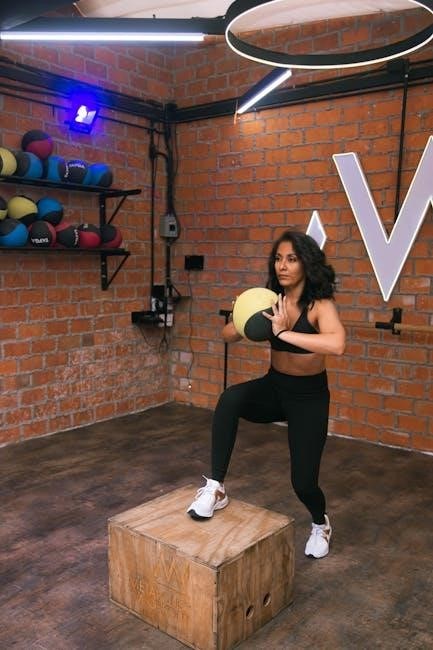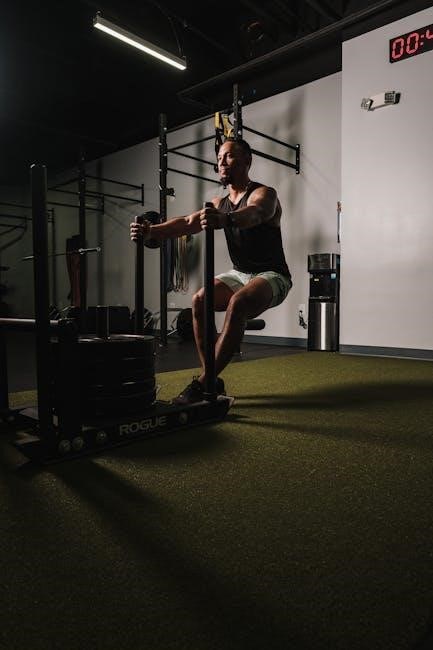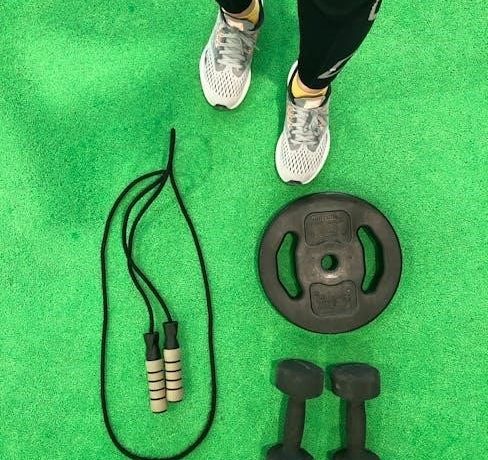HIIT (High-Intensity Interval Training) involves short bursts of intense exercise followed by brief rest periods. It’s a time-efficient, calorie-burning method ideal for busy schedules and all fitness levels. Combining HIIT with weight training enhances fat loss and muscle strength. The 6-week HIIT workout plan with weights, available as a PDF, offers structured routines for progressive fitness gains. This guide provides a comprehensive approach to transforming your physique and improving overall health through dynamic and engaging workouts.
1.1 What is HIIT?
HIIT, or High-Intensity Interval Training, is a workout method involving short bursts of intense exercise followed by brief periods of rest or low-intensity activity. It’s designed to maximize calorie burn and cardiovascular benefits in minimal time. Typically, HIIT sessions last 15-30 minutes, making it ideal for busy individuals. The intense intervals push your heart rate up, while the rest periods allow for partial recovery. This cycle is repeated for the duration of the workout. HIIT is versatile, adaptable to all fitness levels, and can be done with or without equipment, making it a popular choice for home and gym workouts alike.
1.2 Benefits of HIIT for Weight Loss and Fitness
HIIT is renowned for its exceptional calorie-burning efficiency, both during and after workouts. By triggering Excess Post-Exercise Oxygen Consumption (EPOC), HIIT increases metabolism, leading to prolonged fat burning. This method also enhances cardiovascular health, boosts endurance, and improves insulin sensitivity. Unlike traditional cardio, HIIT achieves these benefits in less time, making it ideal for weight loss and fitness goals. The combination of intense bursts and rest periods promotes muscle toning while elevating heart rate, offering a holistic approach to improving overall health and physical performance. Its adaptability to all fitness levels further solidifies its popularity as an effective workout strategy.

1.3 Why Choose HIIT for Busy Schedules
HIIT is perfect for individuals with limited time, offering significant fitness benefits in shorter sessions compared to traditional workouts. Its structure of short bursts of intense exercise followed by brief rest periods maximizes efficiency. With routines lasting 20-30 minutes, HIIT fits seamlessly into busy schedules. It’s also versatile, requiring minimal to no equipment, making it ideal for home or travel. The time-efficient nature of HIIT ensures consistent progress without extensive time commitment, making it a practical choice for those seeking to balance fitness with a hectic lifestyle. This flexibility allows anyone to maintain a healthy routine effortlessly.
Understanding the 6-Week HIIT Workout Plan with Weights
This structured 6-week program combines HIIT with weight training, focusing on a push-pull-leg split. It progresses from foundational workouts to more intense routines, ensuring balanced growth and recovery.
2.1 Overview of the 6-Week Program
This 6-week HIIT workout plan combines high-intensity interval training with weightlifting, structured around a push-pull-leg (PPL) split. Weeks 1-3 focus on foundational strength and endurance (Workout A), while Weeks 4-6 introduce advanced intensity (Workout B). Each phase includes rest days to promote recovery. The program is designed to maximize fat loss, build muscle, and enhance metabolic health. Workouts are time-efficient, lasting 20-30 minutes, and include a mix of cardio and strength exercises. A downloadable PDF guide provides detailed routines, ensuring a clear and organized approach to achieving fitness goals. Proper form and progression are emphasized throughout.
2.2 Combining HIIT with Weight Training for Maximum Results
Combining HIIT with weight training creates a powerful synergy, boosting fat loss and muscle growth. HIIT’s calorie-torching intervals enhance cardiovascular fitness, while weight training builds strength and increases metabolism. This hybrid approach maximizes time efficiency, delivering both cardio and strength benefits in one session. The program integrates HIIT with a push-pull-leg (PPL) split, ensuring balanced development. By leveraging EPOC, HIIT extends calorie burning post-workout, aiding weight loss. This combination enhances overall fitness, improves muscle tone, and supports long-term metabolic health, making it ideal for those seeking a lean, strong physique. Proper progression ensures safety and effectiveness for all fitness levels.
2.3 How to Progress Through the Workout Phases
The 6-week HIIT workout plan is divided into two phases to ensure progressive overload and adaptation. Weeks 1-3 focus on building a foundation with Workout A, a structured push-pull-leg HIIT routine. As you advance to Weeks 4-6, Workout B introduces increased intensity and volume, challenging strength and endurance further. Adjust weights and intensity based on fitness levels, ensuring proper form to prevent injury. The program follows an asynchronous format, allowing rest days to shift and optimize recovery. Progression is key to maximizing results, with exercises tailored to individual capabilities while maintaining a focus on consistent improvement and safety.

The Science Behind HIIT and Weight Loss
HIIT triggers EPOC, boosting metabolism and burning calories post-workout. It enhances cardiovascular health, elevates VO2 max, and improves insulin sensitivity, making it highly effective for fat loss and metabolic improvement.
3.1 How HIIT Boosts Metabolism
HIIT significantly boosts metabolism by triggering Excess Post-Exercise Oxygen Consumption (EPOC), increasing the body’s oxygen demand post-workout. This means your body burns more calories restoring itself, even after the session ends. The intense bursts of exercise elevate resting metabolic rate (RMR), enhancing calorie burn at rest. HIIT also stimulates the production of fat-burning enzymes and hormones, such as epinephrine, which accelerate fat metabolism. This metabolic surge can last up to 24 hours, making HIIT highly effective for weight loss and improving long-term metabolic health, especially when combined with a structured workout plan like the 6-week HIIT program with weights.

3.2 The Role of EPOC in Fat Burning
EPOC, or Excess Post-Exercise Oxygen Consumption, plays a critical role in fat burning after HIIT workouts. During HIIT, your body depletes oxygen stores, creating an oxygen deficit. Post-workout, your body works to replenish this deficit, burning additional calories to restore energy stores, repair tissues, and return to a resting state. This increased oxygen consumption accelerates fat metabolism, enhancing weight loss. EPOC can remain elevated for up to 24 hours, making HIIT particularly effective for sustained fat burning and metabolic boosts, even after the workout ends. This phenomenon is a key reason HIIT is superior to steady-state cardio for efficient fat loss.
3.3 Improving Cardiovascular Health Through HIIT
HIIT significantly enhances cardiovascular health by elevating heart rate and improving cardiac function. The intense bursts of exercise increase VO2 max, the body’s ability to use oxygen during exercise, boosting endurance. HIIT also strengthens the heart muscle, improving its efficiency at pumping blood. Regular HIIT sessions enhance blood flow, lower resting heart rate, and improve insulin sensitivity. These adaptations reduce the risk of cardiovascular diseases and improve overall heart health. The combination of high-intensity bursts and recovery periods trains the heart to function more effectively, making HIIT an excellent choice for improving cardiovascular fitness in a time-efficient manner.

Effective HIIT Exercises for All Fitness Levels
HIIT exercises include bodyweight movements like burpees and jump squats, dumbbell workouts for added intensity, and machine-based routines for variety. These exercises cater to all fitness levels, enhancing endurance, burning fat, and improving overall fitness efficiently.
4.1 Bodyweight HIIT Exercises for Home Workouts
Bodyweight HIIT exercises are perfect for home workouts, requiring no equipment and minimal space. Examples include burpees, jump squats, mountain climbers, and plank variations; These exercises improve cardiovascular fitness, burn calories, and build strength; HIIT workouts like these are efficient, time-saving, and suitable for all fitness levels. They can be scaled up or down depending on individual capabilities, making them versatile for anyone looking to stay active at home. Incorporating bodyweight HIIT into your routine ensures a full-body workout without the need for gym equipment, making it ideal for busy schedules and home-based fitness plans.
4.2 Dumbbell HIIT Workouts for Added Intensity
Dumbbell HIIT workouts add resistance to your routine, amplifying intensity and muscle engagement. Exercises like dumbbell swings, thrusters, and snatches target multiple muscle groups while elevating heart rate. These workouts are ideal for full-body conditioning, improving strength, and enhancing cardiovascular health. Incorporating dumbbells into HIIT sessions increases calorie burn and boosts the afterburn effect, known as EPOC. With minimal equipment, dumbbell HIIT is versatile and effective for home or gym use. Adjust weights according to fitness levels to maximize results while maintaining proper form and safety. This approach ensures a challenging yet scalable workout for all individuals aiming to push their limits.
4.3 Machine-Based HIIT Workouts for Variety
Machine-based HIIT workouts offer a unique way to diversify your routine while targeting specific muscle groups. Treadmills, ellipticals, and cable machines provide controlled resistance, allowing for precise intensity adjustments. These workouts are great for adding variety to your training, ensuring muscle engagement, and preventing plateaus. Incorporate machine-based HIIT sessions to enhance cardiovascular fitness, improve muscular endurance, and boost overall performance. By alternating between different machines, you can keep workouts dynamic and engaging. This approach also allows for easy progression by increasing resistance or intensity levels over time, making it suitable for all fitness levels. Machines add structure and variety to HIIT routines, ensuring a well-rounded fitness experience.

Safety and Precautions for HIIT Workouts

Proper form and warm-ups are crucial to prevent injuries. Ensure adequate recovery days and avoid overtraining. Start with lighter weights and progress gradually to maintain safety and effectiveness.
5.1 Potential Risks and Injuries to Avoid
HIIT workouts, while effective, carry risks due to their high intensity. Common injuries include muscle strains, joint sprains, and cardiovascular overexertion. Improper form during exercises like burpees or jump squats can lead to injuries. Overtraining without adequate recovery increases the risk of fatigue, burnout, and overuse injuries. Beginners and those with pre-existing health conditions are more vulnerable. To minimize risks, ensure proper warm-ups, use lighter weights initially, and focus on maintaining correct form throughout exercises. Consulting a fitness professional can also help tailor workouts to individual capabilities and reduce injury risks.

5.2 Importance of Proper Form and Warm-Up
Proper form and warm-ups are crucial for safely maximizing HIIT workout benefits. Incorrect form can lead to injuries, while a dynamic warm-up prepares muscles for intense exertion, reducing injury risk. A 5-10 minute warm-up with light cardio and mobility exercises ensures readiness. Similarly, a cool-down with stretching aids recovery. Focusing on proper form enhances exercise effectiveness and prevents overuse injuries. Prioritizing form and warm-ups is essential for sustainable, injury-free progress in HIIT training, especially when combining with weights or advanced movements.
5.3 Balancing HIIT with Recovery Days
Recovery days are essential for balancing HIIT workouts, as they allow your body to heal and rebuild. Overtraining without adequate rest can lead to fatigue, injuries, and decreased performance. Incorporating rest or active recovery, such as light yoga or walking, helps maintain progress. HIIT’s high intensity demands sufficient downtime to optimize muscle repair and metabolic adaptation. Neglecting recovery can hinder results, while prioritizing it enhances endurance and strength gains. Balancing HIIT with recovery ensures a sustainable fitness journey, preventing burnout and supporting long-term success in your 6-week workout plan.

Sample Workouts from the HIIT PDF Guide
Discover effective HIIT routines like Day 1: Full Body Blast, Day 2: Core and Cardio Focus, and Day 3: Strength and Endurance Training. These workouts combine burpees, jumping jacks, mountain climbers, and core exercises for a calorie-torching, time-efficient session. Perfect for all fitness levels, these sample workouts from the PDF guide are designed to boost metabolism, improve cardiovascular health, and build strength. Download the guide for detailed plans and transform your fitness journey with these high-energy, results-driven workouts.
6.1 Day 1: Full Body Blast HIIT
Start your fitness journey with the Full Body Blast HIIT workout, designed to engage every muscle group and kickstart your metabolism. This 20-minute session includes dynamic exercises like burpees, jumping jacks, mountain climbers, and plank variations. Each exercise is performed for 20-30 seconds, followed by a 10-15 second rest period. Repeat circuits for 3-4 rounds to maximize intensity. The workout focuses on improving cardiovascular endurance, burning calories, and building strength. It’s an excellent way to introduce your body to HIIT’s high-energy format. Follow the PDF guide for detailed instructions and progression tips to ensure a safe and effective session.
6.2 Day 2: Core and Cardio Focus
Day 2 emphasizes core strength and cardiovascular endurance through a dynamic HIIT session. Exercises include plank variations, Russian twists, jump squats, and sprint intervals. Each exercise is performed for 20-30 seconds, followed by a 10-second rest, repeated for 3-4 rounds. This workout targets the abs, obliques, and heart rate, improving core stability and burning calories. Incorporate movements like bicycle crunches and burpees for added intensity. The session ends with a cooldown to promote recovery. Follow the PDF guide for proper form and progression tips to maximize results while minimizing injury risk.
6.3 Day 3: Strength and Endurance Training
Day 3 focuses on building strength and endurance with a mix of weighted exercises and HIIT. Exercises include weighted squats, push presses, and weighted lunges, performed for 30 seconds of work followed by 10 seconds of rest. This session targets major muscle groups, enhancing muscular endurance and metabolic rate. Incorporate core-strengthening moves like weighted planks and Russian twists. The workout concludes with a cooldown to aid recovery. Follow the HIIT PDF guide for exercise variations and progression tips, ensuring proper form to avoid injury and maximize results. This session is designed to push your limits while building overall resilience.
6.4 Day 4: Active Recovery and Mobility
Day 4 emphasizes active recovery and mobility to enhance flexibility and muscle repair. Engage in low-intensity activities like yoga, dynamic stretching, or light swimming to promote blood flow without overexertion. Incorporate foam rolling and self-myofascial release to reduce muscle soreness. Focus on mobility drills for joints, such as hip circles and arm swings, to improve range of motion. This day is crucial for allowing your body to recover while maintaining movement. Follow the HIIT PDF guide for tailored recovery routines to replenish energy and prepare for upcoming workouts, ensuring long-term progress and injury prevention.
Customizing Your HIIT Workout Plan
Tailor your HIIT workout by adjusting intensity, incorporating exercises, and modifying schedules. Use the PDF guide to personalize routines, ensuring they align with your fitness goals.
7.1 Adjusting Weights and Intensity Levels
Customize your HIIT workout by adjusting weights and intensity to suit your fitness level. Start with lighter weights to minimize injury risks, then gradually increase as you build strength. For intensity, focus on short bursts of maximum effort followed by recovery periods. The HIIT PDF guide offers structured progression, ensuring you challenge yourself without overexertion. This balanced approach helps maintain form and prevents burnout, making your workouts both effective and sustainable. Tailor intensity levels to match your goals, whether fat loss or muscle gain.
7.2 Incorporating Diet and Nutrition Tips
A well-balanced diet is crucial for maximizing HIIT results. Focus on consuming lean proteins, healthy fats, and complex carbohydrates to fuel workouts and aid recovery. Hydrate adequately before, during, and after sessions. Aim for pre-workout meals rich in carbs and protein to boost energy levels. Post-workout, prioritize protein and vegetables to promote muscle repair and recovery. Avoid processed foods and excessive sugar to maintain fat loss progress. Tailor your nutrition plan to align with your fitness goals, whether weight loss, muscle gain, or improved endurance. Proper nutrition enhances the effectiveness of HIIT workouts and supports overall health.
7.3 Tracking Progress and Staying Motivated
Tracking your progress is essential for staying motivated during your HIIT journey. Use a workout journal or mobile app to log exercises, weights, and completion times. Celebrate small milestones, like increasing reps or reducing rest periods, to stay encouraged. Set realistic goals and remind yourself why you started. Surround yourself with a supportive fitness community, such as WhatsApp or Telegram groups, for accountability and inspiration. A positive mindset and consistent effort will keep you driven. Stay motivated by rewarding yourself for achievements and embracing the transformative power of HIIT.

Transform your fitness journey with HIIT! Download the 6-week HIIT workout PDF, join a fitness community for support, and stay consistent to achieve your goals effectively.
8.1 The Importance of Consistency
Consistency is the cornerstone of achieving success with HIIT training. Regularly performing the workouts as outlined in the PDF guide ensures sustainable progress in fat loss, strength, and cardiovascular health. Even with the time-efficient nature of HIIT, skipping sessions can hinder results. By sticking to the 6-week plan, you build endurance, boost metabolism, and maintain motivation. Remember, every session counts, and consistency is key to unlocking your full potential and transforming your body effectively.
8.2 Downloading the HIIT Workout PDF
Downloading the HIIT workout PDF provides convenient access to a structured, 6-week fitness plan. This comprehensive guide includes detailed routines, exercises, and progression tracking, ensuring you stay organized and motivated. Available in a user-friendly format, the PDF can be printed for easy reference or saved on your device for on-the-go access. Its clear layout and actionable content make it an essential tool for anyone committed to transforming their physique. By downloading the PDF, you gain a roadmap to success, helping you maximize each workout and achieve your fitness goals efficiently.
8.3 Joining a Fitness Community for Support
Joining a fitness community enhances your HIIT journey by providing motivation, accountability, and expert guidance. Platforms like WhatsApp and Telegram offer daily workout challenges and tips to keep you engaged. Sharing progress with like-minded individuals fosters camaraderie and encouragement, helping you stay consistent; Many communities also provide access to exclusive content, such as nutrition advice and recovery tips. Being part of a group ensures you’re supported every step of the way, making your fitness goals feel achievable and fun. Active participation in these communities can significantly boost your morale and dedication to your HIIT program.
